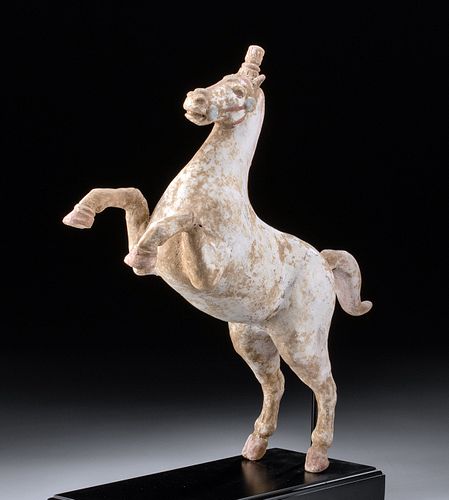Greek Canosan Polychrome Terracotta Rearing Horse
Lot 28
About Seller
Artemis Fine Arts
686 S Taylor Ave, Ste 106
Louisville, CO 80027
United States
Selling antiquities, ancient and ethnographic art online since 1993, Artemis Gallery specializes in Classical Antiquities (Egyptian, Greek, Roman, Near Eastern), Asian, Pre-Columbian, African / Tribal / Oceanographic art. Our extensive inventory includes pottery, stone, metal, wood, glass and textil...Read more
Estimate:
$3,000 - $4,500
Absentee vs Live bid
Two ways to bid:
- Leave a max absentee bid and the platform will bid on your behalf up to your maximum bid during the live auction.
- Bid live during the auction and your bids will be submitted real-time to the auctioneer.
Bid Increments
| Price | Bid Increment |
|---|---|
| $0 | $25 |
| $300 | $50 |
| $1,000 | $100 |
| $2,000 | $250 |
| $5,000 | $500 |
| $10,000 | $1,000 |
| $20,000 | $2,500 |
| $50,000 | $5,000 |
| $100,000 | $10,000 |
| $200,000 | $20,000 |
About Auction
By Artemis Fine Arts
Oct 8, 2020
Set Reminder
2020-10-08 10:00:00
2020-10-08 10:00:00
America/New_York
Bidsquare
Bidsquare : Exceptional Antiquities, Asian, Ethnographic
https://www.bidsquare.com/auctions/artemis-gallery/exceptional-antiquities-asian-ethnographic-5796
Museum-worthy examples of Egyptian, Greek, Roman, Etruscan, Near Eastern, Far East / Asian, Pre-Columbian, African / Tribal,Oceanic, Native American, Spanish Colonial, Russian, Fossils, Ancient Jewelry, Fine Art, so much more! Artemis Fine Arts info@artemisgallery.com
Museum-worthy examples of Egyptian, Greek, Roman, Etruscan, Near Eastern, Far East / Asian, Pre-Columbian, African / Tribal,Oceanic, Native American, Spanish Colonial, Russian, Fossils, Ancient Jewelry, Fine Art, so much more! Artemis Fine Arts info@artemisgallery.com
- Lot Description
Magna Graecia, Southern Italy, Apulia, Greek colony of Canosa, ca. 4th to 3rd century BCE. A dynamic sculpture of a rearing horse presented standing upon its hind legs with the forelegs lifted off the ground. As is customary with Canosan pottery, the artist embellished the form with liberal fugitive pigments. The equine's body is painted white with pink hooves, a blue and red bridle, a pink mane, and pink topknot. Horses were special subjects for ancient Greek artisans, because they indicated wealth to the Greeks of this period. Such statues were oftentimes left as votive burial offerings most likely to reinforce the elite status of the deceased. Size: 11.25" L x 11.125" H (28.6 cm x 28.3 cm); 12.125" H (30.8 cm) on included custom stand.
See a pair of similar Canosan terracotta horses that sold for $20,000 at Christie's 9 December 2015, lot 34
Another pair sold for $54,000 at Christie's New York - 7 December 2006, Lot 108.
Provenance: ex-private New York, New York, USA collection, 1970s; ex-Pietro Tozzi collection
All items legal to buy/sell under U.S. Statute covering cultural patrimony Code 2600, CHAPTER 14, and are guaranteed to be as described or your money back.
A Certificate of Authenticity will accompany all winning bids.
We ship worldwide and handle all shipping in-house for your convenience.
#159178Repairs to both forelegs, tail, and hooves on hind legs, with small chips and light adhesive residue along break lines. Loss to right ear as shown. Abrasions and fading to pigmentation in several areas, with light encrustations, and softening to some finer details on head. Great remains of original pigment throughout.Condition
- Shipping Info
-
All shipping is handled in-house for your convenience. Your invoice from Artemis Gallery will include shipping calculation instructions. If in doubt, please inquire BEFORE bidding for estimated shipping costs for individual items.
-
- Buyer's Premium



 EUR
EUR CAD
CAD AUD
AUD GBP
GBP MXN
MXN HKD
HKD CNY
CNY MYR
MYR SEK
SEK SGD
SGD CHF
CHF THB
THB
















